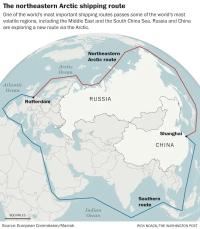 When the ultra-large container ship Ever Given blocked traffic in the Suez Canal recently, Russia’s energy ministry saw an opportunity. The ministry suggested that the shutdown of the canal highlighted the safety and sustainability of its Northern Sea Route (NSR).
When the ultra-large container ship Ever Given blocked traffic in the Suez Canal recently, Russia’s energy ministry saw an opportunity. The ministry suggested that the shutdown of the canal highlighted the safety and sustainability of its Northern Sea Route (NSR).
Nikolai Korchunov, Russia’s envoy for international cooperation in the Arctic, said that the Suez Canal blockage should press the world to look at the NSR as an alternative.
“The incident in the Suez Canal should make everyone think about diversifying strategic sea routes amid the increasing scope of sea shipping,” he said. Korchunov added that there was “no alternative” to the NSR.
The Northern Sea Route through the Russian Arctic significantly shortens the distance of shipping routes as compared to the Suez Canal, depending on the destination. For example, Rotterdam to Shanghai is 30% shorter; Rotterdam to Yokohama is 40% shorter; and Kirkenes to Yokohama is 56% shorter. The NSR is also roughly 60% shorter than rounding the Cape of Good Hope.
The challenge of the NSR has always been ice, requiring icebreaker escort depending on the season and the conditions. In recent years, climate change has dramatically reduced Arctic ice. This January, three ice-capable LNG carriers traveled the length of the route without an icebreaker escort for the first time during the middle of winter.
At least one study has predicted that the significant tonnage will shift from the Suez Canal to the NSR in the coming years. If so, the shift could mark the beginning of a new era in Arctic commercial shipping between three regions — Asia, North America and Europe — whose exports account for almost 90 percent of world trade.
The NSR may be a shorter route but has a long way to go to challenge the Suez Canal. Cargo volumes on the NSR reached almost 33 million tonnes last year and the energy ministry expects that to hit 80 million per year by 2024. By comparison, traffic through the Suez Canal exceeded one billion tons of cargo in 2020.
Thanks to Alan Rice for contributing to this post.
